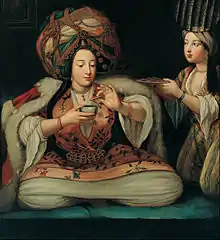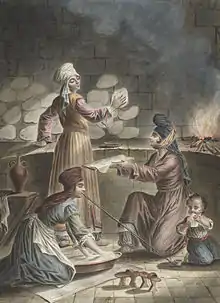Ottoman cuisine
Ottoman cuisine is the cuisine of the Ottoman Empire and its continuation in the cuisines of Turkey, Greece, the Balkans, and parts of the Caucasus and the Middle East.
| Culture of the Ottoman Empire |
|---|
.svg.png.webp) |
| Visual arts |
| Performing arts |
| Languages and literature |
| Sports |
| Other |

History

The Seljuk era foodways of the Turkic tribes, influenced by the cultures they had encountered during their migrations from the Altay Mountains to Anatolia, was characterized by wheat and mutton dishes, with seafood dishes becoming more prominent following their expansion to coastal regions.[1]
Ottoman cuisine represents the synthesis of these Central Asian, Iranian, Arab and Anatolian roots with other foodways that were introduced during expansionary phases, including Hungarian, Albanian, Greek, Romanian, Serbian, Bulgarian and Bosnian cuisine.[1] According to Fragner, while the origins of the legacy are impossible to ascertain, this form of "mutual exchange and enrichment" is a typical feature of culinary history.[2]
Maxime Rodinson has argued that food historians "need to show that they do not have a common, parallel origin in Graeco-Roman cooking before we adduce any oriental influence" of foods. According to Rodinson, this is because Latin Europe, Islam and the Byzantine Empire all evolved from "the civilization of antiquity".[3]
The influence of Ottoman cuisine in Europe beginning in the early 16th-century is seen in dishes like sharbat, which spread first to Italy after Franceso I de'Medici requested a recipe for "Turkish sorbette" in 1577. Rice pudding, described in contemporaneous sources as "Turkish-style rice", was served at the wedding of Ercole I d'Este, Duke of Ferrara in 1529. Koz halva (a type of nougat), first recorded in a 13th-century Arabic cookbook, is found in Central European cuisine, where it is called Törökméz ("Turkish honey") in Hungarian, and Türkischer Honig in Austria and southern Germany.[4]
Ottoman cuisine also incorporates many New World foodstuffs, which contributed to the development of the cuisine's unique character as compared to its predecessors and its neighbors.
Characterstics
The Ottoman Empire spanned three continents, representing a wide range of climate zones and flora and fauna, and so the cuisine includes not only the cuisine of the Ottoman Palace, but a rich diversity of regional specialties.[5]
Butter
Clarified butter was the favorite cooking fat of the Ottoman Palace. Olive oil, although used in the palace cooking since the time of Fatih Sultan Mehmet, was used mostly for lighting lamps and in the manufacture of soaps.[6][7]
Soups
Marianna Yerasimos has proposed a classification of Ottoman soups (Ottoman Turkish: چوربا) based on ingredients:[8]
- Pasta
- Seeds
- Chicken
- Meat
- Vegetables
- Pulses
- Dairy
Hans Dernschwam, a 16th-century German traveler, confirms that çorba was a common dish of this period, prepared with butter and rice for the janissary corps. According to Dernschwam, most 16th-century Ottoman soups began with a base of chicken stock and rice, with different vegetables added, although lamb stock was also used.[8]
Soup could be thickened with a mixture of egg and flour or bread and an acidic ingredient such as lemon juice, and served over stale bread. This style of soup could be found, with some variations, in Balkan territories like Romania and Hungary, as well as in Turkey.[8]
Hand-cut soup noodles called erişte are a basic dish found in Central Asian cuisine.[8]
Desserts
Sugar was still prohibitively costly in the 17th-century; far more common were honey and syrups like pekmez, made with grapes.
The wheat berry pudding aşure, in modern times a part of the Islamic holy day Ashura, has roots in the harvest rituals of the Neolithic period, since which time domesticated wheat is known to have been cultivated at Karaca Dağ.[4]
There are multiple competing theories of the origin of baklava, variously ascribing it to the Ancient Roman placenta cake, Perisan lauzinaj or the influence of Central Asian desserts, found also in the layered dessert güllaç, thin sheets of pastry dough soaked in rosewater-infused milk and layered with chopped nuts and pomegranate.[4] Dernschwam describes a baklava-like dish made by cooking thin wafers of starch flour and egg white, then filling with layers of sugared nuts with rosewater and nutmeg to create a dessert about as thick as a finger.
Majun, compote and halva were sweets made by palace chefs.[5]
Dernschwam describes zerde as rice pudding that is cooked in honeyed water and colored with saffron, garnished with toasted almonds and served with fruits. Muhallebi is also listed among the foods Dernschwam encountered on his travels.
Pickles
Dernschwam wrote that, while cabbage was found, the Turks did not know how to cook it with beef like the Hungarians, saying they instead pickled it, a common preparation in those days.[9]
Stuffed dishes
Dernschwam described a dish stuffed vegetable dish of young pumpkins and aubergines (which he calls podliczschan), stuffed with cubed mutton and garlic filling, and served with yogurt. He also describes the dish called sarma or stuffed vine leaves cooked with sour plums, which he compares with a rolled krapfen (a type of filled pastry from German cuisine).
Ottoman palace cuisine
Of the four Ottoman Palaces, Edirne Palace, Topkapı Palace, Dolmabahçe Palace and Yıldız Palace, it is Topkapı that for 400-years oversaw the development of the classical Ottoman palace cuisine. Topkapı could host up to 4,000 persons at a time and the kitchen staff was huge. At one 18th-century event at least 1,000 chefs were required to prepare a meal of pilaf, soup and zerde for 10,000 attendant janissaries.[5]
A palace register from 1692 lists different kinds of vegetables eaten in the palace, squash (kabak-ı Mısır), celery, lettuce (marul), cucumber, garlic, aubergins, borage (lisan-ı seveir), cowpeas, spinach, turnips, vine leaves, Jew's mallow (müluhiye), beets, carrots and okra. Parsley, dill, mint, and tarragon are also listed among the foodstuffs allocated for the Sultan. Green tomatoes (kavata) are listed for the Hasseki Sultan (the Sultan's favorite concubine), who also received snow for iced coffee and to cool sharbat and hoşab. Chicken was reserved for the elite, and pigeon only for the Sultan, hasseki, other potential concubines and princesses. Some large portions allotted to non-imperial high-ranking servants like the female steward of the harem, who received one sheep and 10 chickens per day, indicate that persons in these roles were responsible for feeding their subordinates.[10]
Ottoman palace cuisine was amalgamated and honed in the Imperial Palace's kitchens by chefs brought from certain parts of the empire to create and experiment with different ingredients. These chefs were tested and hired by their method of cooking rice, a simple dish. They were brought over from various places for the express purpose of experimenting with exotic textures and ingredients and inventing new dishes.
Each cook specialized in specific tasks. All dishes intended for the sultan were first passed by the palate of the Chesnidjibashi, or imperial food taster, who tested the food for both poison and taste. The creations of the Ottoman palace's kitchens also filtered to the common population, for instance through Ramadan events, and through the cooking at the yalis of the pashas, and from there on to the people at large.
Some of the more extravagant dishes remained as palace specialities and have had only limited diffusion:
Terminology
The culinary terminology of Ottoman Turkish includes many Persian loanwords:[1]
Other culinary terms that have entered the Turkish language reveal an assortment of linguistic influences like Italian (barbunya), Greek (fasulye), Chinese (manti) and Arabic (muhallebi).[1]
Beginning in the 19th century the Ottomans began using French culinary terms at diplomatic event. French cuisine was considered, in those times, the epitome of culinary accomplishment and its influence was felt not only in the Ottoman court, but also other European courts, where French chef Marie-Antoine Carême cooked in the imperial kitchens of the Russian Empire, and Alphonse Gouffe was Head Pastry Chef to Queen Victoria. Banquet menus for international dignitaries were written in French and service à la russe replaced service à la française at formal dinners. Ottoman pilaf, börek and kebabs continued to be served. Food remained a symbol of Ottoman power and prestige and the adaptation of French culinary practices to Ottoman palace cuisine reflected the Ottoman desire to prove themselves the cultural equal of Europeans.[15]
Menus of formal banquets at the imperial court dating to the early 20th century show the use of French terms and their Turkish equivalents:
| French | Turkish | English |
|---|---|---|
| Consommé | Et suyu | Meat stock |
| Consommé à la Reine | Et suyu | Meat stock (Chicken consommé thickened with tapioca) |
| Consommé de volaille glacé | Soğuk tavuk suyu | Cold chicken consommé |
| Créme de fruits | Kaymaklı meyve tatlısı | Fruits with whipped cream |
| Fraises voilées | Kaymaklı çilek | Strawberries with whipped cream |
| Gâteux aux fruits | Meyveli pasta | Fruitcake |
| Gâteux aux amandes | Bademli pasta | Almond cake |
| Gâteux Marquise | Çikolata tatlısı | Chocolate Marquise cake |
| Gâteux panaché | Yemişli bademli pasta | Ice-cream cake with fruits |
| Dessert | Şekerleme (candies) | Dessert |
| Gaufrettes Sultanié | Kaymaklı yaprak tatlısı | Sultan's waffles |
| Glace | Dondurma | Ice cream |
| Glace aveline | Dondurma | (Hazlenut) ice cream |
| Granité glacé aux fraises | Çilekli dondurma | Strawberry sorbet |
| Mont Blanc | Mont Blanc pastry | |
| Neige d'Ananas | Ananaslı dondurma | Pineapple sorbet |
| Tarte à la Chambord | Şambor tatlısı | Chambord dessert tart |
| Vacherin Chantilly | Kremalı tatlı | Meringue dessert |
Legacy
Ottoman culinary influence survived the dissolution of the Ottoman Empire in the Fertile Crescent, Anatolia, Balkans and Greece. Fragner notes that these cuisines, in the modern forms, "offer treacherous circumstantial evidence of this fact" of their shared cultural history, but he also notes that "they represent at the same time a good deal of local or regional culinary traditions."[16] Coffeehouses developed first in the Ottoman Empire and spread to Italy, then across Europe.[17]
Bibliography
References
- Kia, Mehrdad (June 15, 2017). The Ottoman Empire: A Historical Encyclopedia. ABC-CLIO. p. 4.
- Fragner, 3
- Rodinson, Maxime. "Venice and the Spice Trade," in Rodinson, Maxime, and Charles Perry. Medieval Arab Cookery: Papers by Maxime Rodinson and Charles Perry with a Reprint of a Baghdad Cookery Book (2006). p. 204
- The Oxford Companion to Sugar and Sweets. Oxford University Press. 2015. p. 747.
- Akkor, Omur (2014). Ottoman Cuisine:A Rich Culinary Tradition. Blue Dome Press.
- Faroqhi, Suraiya (2018). "Should it be Olives or Butter?". Earthly Delights. Brill. pp. 35–38.
- The Illuminated Table, the Prosperous House: Food and Shelter in Ottoman Material Culture. Ergon Verlag. 2003. p. 167.
- Barbu, Violeta (2018). Earthly Delights. Brill. pp. 109–110.
- Krauth findt man, aber die t[urken] kunnens nicht kochen mit rindtfleisch wie in Vngern. Die t[urken] pflegens sawer einzumachen wie auch daussen.
- Reindl-Kiel, Hedda (2018). "Records of Food Distribution in the Saray". Earthly Delights. Brill. pp. 69–79.
- Mehrdad Kia (2011). Daily Life in the Ottoman Empire. ABC-CLIO. pp. 230–. ISBN 978-0-313-33692-8.
- Coşkun Yılmaz; Necdet Yılmaz (2006). Health in the Ottomans. Biofarma.
- Jean-Paul Labourdette; Clémence Bonnet (4 February 2009). Petit Futé Istanbul. Petit Futé. pp. 186–. ISBN 2-7469-2337-8.
- Tarım ve köyişleri bakanlığı dergisi. Yayın Dairesi Başkanlığı Matbaası. 1998.
- De Voogt, Daniëlle De (2013). Royal Taste: Food, Power and Status at the European Courts After 1789. Ashgate Publishing Limited. p. 136.
- Fragner, p. 52
- Shoup, John A. (October 17, 2011). Ethnic Groups of Africa and the Middle East. ABC-CLIO. p. 301.
- Sources
- Bert Fragner, "From the Caucasus to the Roof of the World: a culinary adventure", in Sami Zubaida and Richard Tapper, A Taste of Thyme: Culinary Cultures of the Middle East, London and New York, 1994 and 2000, ISBN 1-86064-603-4.
External links
 Media related to Ottoman cuisine at Wikimedia Commons
Media related to Ottoman cuisine at Wikimedia Commons- Culinary cultures of the Ottoman Empire
